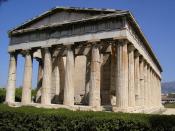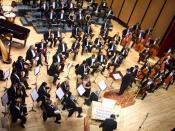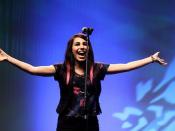The ancient greek theater was composed by three major parts: the Orchestra, the Scene and the main theater, called Koilon.
The Orchestra was the almost circular place, situated in front of the scene (stage) facing the audience. At the center of the orchestra was situated the Thymeli, which at the early years was meant to be an altar and later on, a place, where the leader of the chorus (koryphaios) was standing. Some archaeological research in the Athens aerea gave some clues for the existance of rectangular orchestras in some ancient greek theaters, but the circular shape was the dominant one and also the closest to the dionyssiac cult (the circle was supposed to have supernatural power). The orchestra was the acting place, especially in the early years, although gradually the action moved from the orchestra on the scene and -if we want to be more specific-in front of the scene, which part was called Proscenio, because it was situated in front of the scene (pro+scene).
The side of the Scene facing the audience, served for background as it was decorated as a Palace or a Temple. The scene had one or three entrances for the actors. Later on, as scenography (i.e. theatrical painting) developped, they were placing on the background painted tables with other themes, such as woods, army camps etc.
Between the scene and the seats, there are two entrances, called Parodoi, one on the right and one on the left, from which the chorus and the persons coming from the outside (i.e. not from the Temple nor the Palace) were enering the scene. If someone was entering from the right parodos, that meant that he was coming from the city or the port. If he was coming from the left parodos, he was coming from the fields...



Amazing
I'm actually Greek and I didn't know all these details
well done
0 out of 0 people found this comment useful.